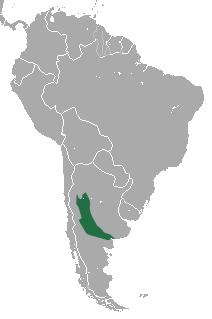Chlamyphorus truncatus
| Pink fairy armadillo | |
|---|---|
 |
|
| Scientific classification | |
| Kingdom: | Animalia |
| Phylum: | Chordata |
| Class: | Mammalia |
| Order: | Cingulata |
| Family: | Chlamyphoridae |
| Subfamily: | Chlamyphorinae |
| Genus: |
Chlamyphorus Harlan, 1825 |
| Species: | C. truncatus |
| Binomial name | |
|
Chlamyphorus truncatus Harlan, 1825 |
|
 |
|
| Pink fairy armadillo range | |
The pink fairy armadillo (Chlamyphorus truncatus) or pichiciego is the smallest species of armadillo (mammals of the families Chlamyphoridae and Dasypodidae, recognized by a bony armor shell), first described by R. Harlan in 1825. This desert-adapted animal is endemic to central Argentina and can be found inhabiting sandy plains, dunes, and scrubby grasslands.
Pink fairy armadillos have small eyes, silky yellowish white fur, and a flexible dorsal shell that is solely attached to its body by a thin dorsal membrane. In addition, its spatula-shaped tail protrudes from a vertical plate at the blunt of its shell. This creature exhibits nocturnal and solitary habits and has a diet that is mainly composed of insects, worms, snails, and various plant parts.
The conservation status for pink fairy armadillo is still uncertain, and it is listed as Data Deficient by the IUCN Red List of Threatened Species. The decline in population for this species has generally been attributed to farming activities and predators including domestic dogs and cats. Pink fairy armadillos are found less commonly than they were a few decades ago, and the field sightings have been rare and incidental. Individuals that have been caught in the wild had a tendency to die during or a couple days after they were transported from their natural habitat to captive facilities. There is a sole record for the longevity of a pink fairy armadillo that was held in captivity more than 4 years; however, that particular case lacks proper scientific description and thus cannot be considered fully valid. Armadillos' evolutionary distinctiveness, combined with their restricted geographic range, ongoing threats, and rarity makes the urgent conservation attention extremely important for these species.
...
Wikipedia

